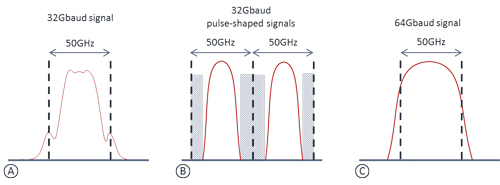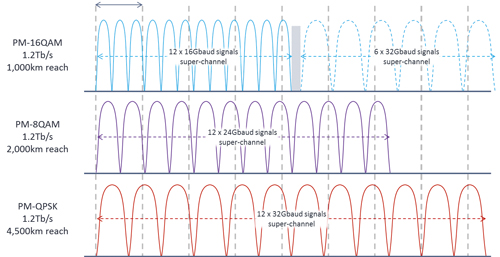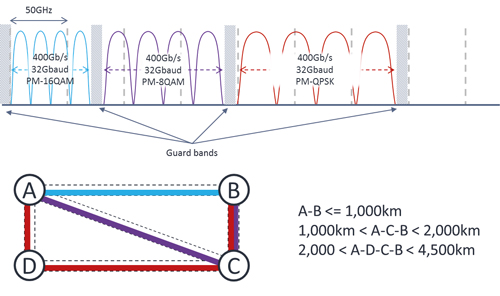Since products based on coherent super-channels hit the market in mid-2012, this technology has transformed the way that service providers deploy long-haul capacity. A super-channel is an evolution in DWDM technology in which multiple optical carriers, implemented on a single line card, are seen as a single unit of capacity, and are brought into service in one operational cycle. Super-channels take the spectral efficiency that is delivered by a coherent transponder and make it operationally scalable beyond 100Gb/s.
As this technology advances, there have been a series of enhancements that roughly follow the progression:
- The move from hard-decision to soft-decision forward error correction (SD-FEC), delivering almost a doubling in the reach for a given type of modulation.
- The move from fixed grid to flexible grid. Flexible grid forms the foundation of future super-channel capabilities, as I will explain below.
- The addition of a ‘fluid’, or ‘instant’ bandwidth capability, in which a full super-channel can be installed, but service providers activate 100G chunks of it using a license system.
- Most recently the proposal is to take the capacity from a super-channel line card and allow it to be ‘sliced’ so that it can be optically directed to different end points. This is particularly useful in metro aggregation scenarios to maintain capacity efficiency as the network scales.
From the very beginning of commercial shipments, super-channel line cards have used ‘soft optics’ – the ability to program in a ‘flexible coherent’ modulation technique to allow network designers to optimise the reach and capacity on a given optical link. Last year I was lucky enough to be involved in a field trial of a prototype terabit super-channel line card in which we showcased a full range of these modulations types: PM-BPSK, PM-3QAM, PM-QPSK, PM-8QAM and PM-16QAM modulation, on the same line card, over a link between Budapest in Hungary and Bratislava in the Slovak republic (see explanation of terms).
In the first-generation line cards switching, for example, from PM-QPSK to PM-BPSK had the effect of massively increasing the potential reach (from about 4,500km to more than 10,000km). But in doing this the line card capacity dropped from 500Gb/s to 250Gb/s, and the maximum fibre capacity was also be halved. Note that this is the reason why PM-3QAM is so valuable, because it offers an intermediate reach, intermediate card capacity and intermediate fibre capacity between PM-BPSK and PM-QPSK.
The next generation of super-channel technology adds another variable – the ability to switch the baud rate of the signal to create another dimension of programmability. So why would a programmable baud rate be so important? Before I answer that let me lay out two disclaimers. First, all of the examples I will give are just that – examples. They are not intended to be specific future product specifications and have been kept as generic as possible. Second is that the spectral widths are approximate; I’ve avoided a direct statement of spectral widths. The actual spectrum used by individual carriers will vary depending on the SD-FEC overhead for a given manufacturer, as well as other details of the implementation.
In Figure 1a I have shown a typical pulse shape and width for a widely used 100Gb/s implementation, which is 32Gbaud PM-QPSK. This has a central ‘bump’ and two side lobes. In fact there are an infinite number of these lobes, but they decay rapidly, and so we typically just draw the first order lobes. This type of signal just about fits into a classic 50GHz fixed slot defined in ITU-T G.694.1, and the small amount of ‘spillage’ (known as inter-symbol interference, ISI) to neighbouring channels is one of the factors that limits reach in these implementations.

Figure 1
The latest coherent technology uses transmitter-based pulse shaping to move the energy from the side lobes into the central pulse, to create the signals shown in Figure 1b. These fit easily into a 50GHz slot, so much so that there’s a significant amount of wasted spectrum, shown as shaded areas between the peaks. The fixed, 50GHz ITU grid would be an inhibitor to efficient use of spectrum for this type of implementation.
So Figure 1c shows what the peak would look like if we simply ramp up the baud rate from 32Gbaud to 64Gbaud. If we stay with PM-QPSK modulation this would double the data rate on this carrier to 200Gb/s, but the peak would be twice as wide. This is a key point, because increasing the baud rate on its own has no effect on the spectral efficiency (i.e. total fibre capacity) in this system. If we wanted to increase the spectral efficiency here we’d need to move to a higher order modulation technique, such as PM-8QAM or PM-16QAM. A 64Gbaud PM-8QAM format would deliver 300Gb/s, and a 64Gbaud PM-16QAM would deliver 400Gb/s on this carrier.
However, there’s a problem. While 32Gbaud optoelectronics is widely available, the industry is approaching a bottleneck for serial data rate processing. In other words we can’t buy (or build) 64Gbaud electronics today, or even in the near term future (let’s say the next two to five years – two years being optimistic and five years pessimistic). Electronic processing power is still increasing, but it does so by mainly delivering parallel processing power. Even if we could create a 64Gbaud serial signal (which has been demonstrated in experiments using specialised test gear), you would see a similar ‘spillage’ outside the fixed 50GHz slot.
ITU-T has already defined a different approach to spectrum management, called flexible grid. In a flexible grid system we define a flexible slot with a granularity of n times 12.5GHz. There can be multiple optical carriers in this flexible slot – so basically flexible grid was designed with super-channels in mind.
Super-channels to the rescue
Let’s now look at how a super-channel approach could help to solve these problems while also providing a lot more flexibility. Earlier I mentioned that switching from PM-QPSK to PM-BPSK halves the capacity of the super-channel line card. Instead we could create an implementation that fixes the capacity of the line card so that we can optimise the use of the switch fabric capacity while still using flexible coherent modulation to optimise the link design.
Figure 2 shows a line card with 12 carriers, because by increasing the number of carriers we can potentially use lower baud rates and still achieve the same spectral efficiency and super-channel payload as a single carrier clocked at a baud rate that is far beyond what current optoelectronics can support.

Figure 2
The blue super-channel at the top of Figure 2 is clocked at 16Gbaud, uses PM-16QAM modulation, and delivers 100Gb/s per carrier for a total capacity of 1.2Tb/s. The typical reach for PM-16QAM in real networks would be about 1,000km (note that this number varies a lot because the reach of PM-16QAM is very dependent on specific installations – something that is true for all vendors, despite some aggressive claims to the contrary).
The purple super-channel in the centre of Figure 2 also has twelve carriers, but is clocked at 24Gbaud, uses PM-8QAM modulation, still delivers 1.2Tb/s, and can now close links up to about 2,000km. The red super-channel at the bottom of Figure 2 is clocked at 32Gbaud, uses PM-QPSK modulation, still delivers 1.2Tb/s, and can close links up to about 4,500km. These examples show that, by manipulating the Baud rate at the same time as changing modulation type we can create a ‘capacity fixed’ implementation.
Now that engineers have this capability they can choose other design options. In the upper right of Figure 2 we see a six-carrier, PM-16QAM super-channel in which each carrier is clocked at 32Gbaud. As you would expect, this has the same spectral efficiency and payload as the twelve-carrier super that is clocked at 16Gbaud. So why would we choose this implementation option?
There are at least two use cases. First is a core network implementation where we want to reduce power consumption, and so can turn off half of the lasers, and more importantly the ASICs that are driving this super-channel. When we do this the higher baud rate will have a negative impact on reach, but perhaps this is an acceptable trade-off. The second example might be a small form factor node used for short-reach applications such as data centre interconnect. In this case only six optical channels would be implemented to save both power and space, yet still achieve maximum density.
A capacity-fixed approach is an essential cost optimisation option for vendors and service providers alike because it allows the optical transport switching platforms to be loaded to their maximum capacity. We know this is an important architectural issue because one of the principle reasons that IP over WDM (IPoWDM) has failed to achieve market traction is that when we switch from grey optics in the router line card to coloured WDM optics we take a big hit in chassis density (typically halving the chassis capacity). Capacity-fixed super-channels enable us to avoid this pitfall.
Some of my colleagues have authored a paper to be presented at the 2015 ECOC conference in Valencia on this very topic (see further reading). This paper uses network modelling to quantify the level of savings from a capacity-fixed approach. They show that a capacity-fixed approach offers reductions in line module and chassis counts leading to lower network cost.
Super-channels, slice by slice
Some of you may be thinking ‘gosh, 1.2Tb/s is a lot of capacity to pay for in one chunk, and it’s also a lot of capacity to have running between the same two points’. The first of these problems is solved by using the instant bandwidth economic model, in which super-channel capacity is activated (and charged for) in 100Gb/s increments using a software license. The second problem is solved by making the super-channel ‘sliceable’.
Remember that all of these super-channels must be optically routed as a single unit. In other words, a ROADM would have to manipulate the full 1.2Tb/s as a single chunk, and any sub-super-channel grooming would be achieved using OTN switching.
Figure 3 shows how a super-channel can be optically divided, by retuning the lasers on the super-channel line card. In a real implementation all of these lasers would be realised using large-scale photonic integrated circuits (PICs) to make it possible to implement so much capacity on a single line card. In this example I have chosen to slice the original super-channel into three, separate 400Gb/s super-channels that are separated by guard bands.
The guard bands allow ROADMs to ‘get hold’ of the individual super-channels so they can be directed over different paths. You will also notice that each super-channel is able to use a different modulation type. A production line card would typically be able to divide up the super-channel capacity with granularity of 100Gb/s in any combination, right down to the maximum of twelve 100Gb/s ‘channels’ separated by guard bands.

Figure 3
Another use for this programmable modulation capability would be in protection scenarios, an example of which is shown in the lower part of Figure 3. Let’s imagine a 100Gb/s service is set up between A and B, a distance of less than 1,000km. This means that PM-16QAM modulation could be used. However, if there is a failure on the fibre between A and B, and only optical protection is used, the next shortest path would be A-C-B, which is between 1,000 and 2,000km long. This is too far for PM-16QAM, but we could reprogram the line cards to use PM-8QAM over the protection path. If there is another failure on the A-C link, we could reprogram the modulation to PM-QPSK and close the even longer link A-D-C-B.
Summary
Coherent super-channels are the preferred technology for implementing high-capacity, long-haul DWDM services. They are also the only technology in production today that offers a clear path to scale continuously beyond 100Gb/s data rates and into the terabit scale for DWDM line cards.
The latest enhancements to this technology provide a fully programmable modulation capability that open up new ways to reduce costs and enhance service quality while continuing to scale to the growing demands of today’s Internet.
Geoff Bennett is the director of solutions and technology at Infinera
Explanation of terms: PM-BPSK: polarisation-multiplexed binary phase-shift keying; PM-QPSK: polarisation-multiplexed quadrature phase-shift keying; PM-3QAM, PM-8QAM, and PM-16QAM: polarisation-multiplexed 3, 8 and 16-state quadrature amplitude modulation.
Further reading:
- Geoff Bennett. ‘Super-Channels: DWDM Transmission at 100Gb/s and Beyond’. Infinera White Paper.
- Onur Turku, Soumya Roy, Abishek Gopalan, Matt Mitchell, and Biao Lu: ‘Comparing Networks with Capacity-fixed and Spectrally-fixed Line Modules Implementing Multiple Coherent Modulations’, Poster ECOC 2015.


